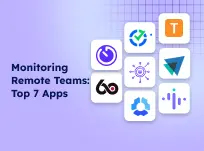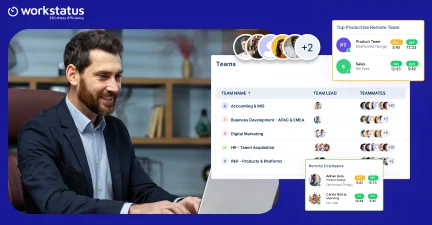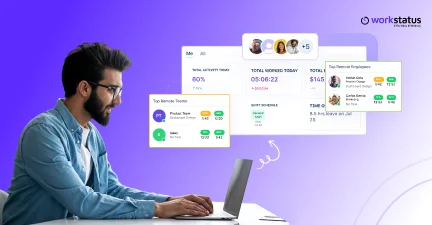Table of Contents
Introduction
Keeping track of employee attendance is important for any business.
Looking at attendance patterns can show you how productive your teams are and if there are any issues.
Did You Know?
Almost 1 out of every 5 employees said they called in sick at least once, even though they were not really sick.
Employers can use data to identify trends, spot problems, and make smart decisions about managing their workers.
This blog post will look at four simple ways to monitor patterns from employee attendance records.
Whether you want to improve efficiency, support employee well-being, or follow rules, these strategies will help you get the most out of your team.
Let’s dive in and explore these attendance monitoring methods.
What do you mean by an Employee Attendance Pattern?
 An employee attendance pattern reveals how often an employee arrives late or on time for work. It also considers the number of times employees are present and absent at work without a good reason. Employees’ start and log-out times are used to calculate their schedules and attendance rates.
An employee attendance pattern reveals how often an employee arrives late or on time for work. It also considers the number of times employees are present and absent at work without a good reason. Employees’ start and log-out times are used to calculate their schedules and attendance rates.
A dedicated employee attendance monitoring system is an excellent method to assess staff participation, work patterns, and overall productivity. Continue reading to learn more about the most effective approach to keep track of your employees’ attendance.
Top 5 benefits of monitoring your employees’ attendance
1) Identify patterns in the absence

Before you can proactively address absence, you need to know what absence means for your workforce. Look at employee absences and consider whether it is reasonable for people to be taking off as much time as they are. If multiple people are calling in sick on any given day, it might be a case of an illness spreading through the office. But if someone is regularly calling out with unrelated illnesses, it might indicate that there’s an underlying issue at play.
Are other employees feeling pressure to pick up shifts? Do some groups of workers take more time off than others? Figuring out what’s causing employee absences can help you best tackle staff issues going forward.
Ensure managers are on top of absence management. If you’re not careful, managers can miss opportunities to keep their teams healthy. Be proactive to know when a particular employee is sick to call in another worker if needed.
2) Detect fraudulent data

Checking up on your employees can also help you keep tabs on their productivity or lack thereof. When you see a string of absences that don’t match up with approved vacation time or sick days, it might be time to dig in and figure out what’s going on. You may discover that someone is working elsewhere and not telling you, or they have a medical condition they’re struggling to cope with and feel they need to hide it from you.
Or maybe nothing is wrong at all – there’s simply been an uptick in employee requests for days off – but if you check in regularly (rather than wait until something comes up), you’ll be able to prevent any issues down the road.
3) Keep Employees Motivated

Keeping track of employee absence gives you a better idea of who performs well and who might need extra attention. By keeping tabs on which workers tend to miss work, you’ll be better able to develop strategies for keeping them engaged and productive. And by encouraging them to improve their attendance record, you can increase their job satisfaction along with productivity. Finally, accurate records help ensure that no one falls through the cracks when it comes time for performance reviews or salary adjustments. When everyone knows what’s expected, there’s less room for confusion – and fewer reasons for slacking off.
Another benefit of tracking your workers’ attendance is that it keeps you better communicating with them. When you have up-to-date information about when they’re scheduled to work, you’ll be more likely to stay in touch and provide support when they need it.
————————————————————————————————————–
Also Read: Location-Based Attendance Tracking with Geofencing
————————————————————————————————————–
4) Improve medical leave management

Medical leave is also called sick leave or disability leave. An employee benefit allows people to receive a portion of their pay for leave when they are injured or sick. This type of leave does not include maternity, vacation, personal, or general holidays.
Businesses keep track of their employees’ medical and disability history to protect themselves from any adverse events that may occur while someone is on medical leave. Businesses keep track of medical/disability absences by having their human resources team monitor employee attendance and key in employee absences into a computer database.
These databases help employers review data such as:
- What percentage of total work hours were missed?
- What time during work hours was missed?
- How many hours did they miss per day?
- How many days per year were missed?
- Which employees have high rates of absenteeism compared to others?
5) Improve workforce productivity

Keeping track of employee attendance helps you ensure that work deadlines and project timelines are met. If your team misses several days or hours, you can quickly analyze if an employee’s absence hurts company performance or productivity. You can also see if a particular individual has a pattern of skipping certain days at work. Overall, being aware of when people show up for work and when they don’t can help reduce absences due to illness, improve overall workforce performance and enhance organizational efficiency.
Managers can use employee absence data to take a more active role in employee productivity. By closely analyzing and reviewing each team member’s attendance trends, you can identify potential problems and suggest solutions to help improve employee productivity.
For example, if you see two employees taking frequent sick days every Friday afternoon, you may want to review their workloads or suggest that they take all vacation requests online rather than requesting time off in person.
Likewise, if an employee always seems to be late for work, you might encourage them to try getting up 15 minutes earlier or make minor adjustments, so they’re not rushing through tasks in a frantic rush.
How to Monitor the Attendance Patterns of your Employees?
Now that you understand an employee attendance pattern, it’s time to learn the tactics you may use to monitor this crucial aspect of your business operations adequately.
1. Figure Out the Types of Workplace Absence

Employees will cite various reasons for their tardiness or absence. Emergencies and critical situations are common causes of excused absences. On the other hand, unexcused absences refer to absences that aren’t authorized by the employee’s boss or that weren’t planned ahead of time.
Employers give sick, and vacation leave credits that employees may use to take one or more days off due to illness, plan their family activities, or take a vacation without losing money.
With these rules in place, understanding the most prevalent types of workplace absences in your firm is critical since it may save you time and money.
It’s also important to pay attention to the reasons for employee absence. You’ll be able to develop appropriate measures to keep happier and healthier employees if you identify the origins of their absenteeism.
Here are some examples of excused absences:
Sick Leave: It is an instance of absence due to a health problem in which going to work may aggravate the medical condition or transmit infection, putting others’ health and safety at risk.
Vacation Leave: This leave of absence must be requested in advance to avoid workplace conflicts for some businesses.
Personal Leave:
An employee’s need for personal time to work on a project or recharge due to burnout is known as this type of absence. It is considered an acceptable absence since it usually includes scheduled activities such as birthdays, marriages, and even unanticipated events like car accidents or illness.
Other: Sympathy or bereavement leave, Family leaves, and jury duty are examples of excused absences.
2. Boost your Employee and HR Relations

There’s a stigma surrounding human resources and employee relations that implies that human resource personnel are pro-management and anti-workers. Some employees may believe they’re involved in some office politics, which can impact your HR and employee relations. As a result, it’s critical to look for methods to improve your HR-employee connections.
Here’s how a solid HR-employee connection may assist in the monitoring and improvement of employee attendance patterns:
Go Deep: Having an excellent HR-employee connection might also help you evaluate employee absence habits by performing a deep analysis of why some of your staff are absent or late. When your staff has confidence in your HR team, you’ll be able to get down and figure out how to assist them in avoiding these issues. This is especially true for people who require any sort of professional assistance.
Build Trust: A positive human resources (HR) relationship may assist you in keeping track of employee attendance habits by developing trust among your staff. When your HR staff understands how to listen and motivate people to share their ideas, they’ll be more comfortable revealing the possible causes for their recurring absences and other attendance issues. This is also true for staff and their bosses.
3. Go for Counselling

Talking with the concerned employee and giving them the assistance they require, such as counselling, is one of the most effective methods to discover staff attendance patterns.
Typically, counselling is an excellent method for the immediate superior to address a specific employee’s issues, such as absenteeism.
Make sure to schedule a counselling session with your employees. Asking them why there is a problem with their attendance will ensure that you get the information you need.
With a little patience and the appropriate strategy, you’ll be able to win your employee’s trust and confidence over time, which will assist them to improve their attendance in the long run.
4. Make use of the Right Tools

A proper employee attendance tracking software tool will assist you in detecting any absenteeism or tardiness concerns among your staff. With the right solutions in place, you’ll be able to figure out why problems with absenteeism arise or recur, as well as the best solutions for them.
Employee attendance tracking systems are now automated and more sophisticated than ever before, allowing you to keep track of staff schedules and check in on attendance correctly. When utilizing this method, employees must enter their valid credentials into an automated system to be recognized as “present” at work.
HR professionals can use the following features of time tracking software to track employee attendance patterns:
- Attendance monitoring data
- Automated time reports
- Online Timesheets for logged hours
- Automated Clock in and Clock out
Having the possibility to randomly see the Employee Live Screen is another way to see how productive your employees are. And also: If the employees know of the possibility, they will be more productive to avoid the boss to catch them wasting time on work. The Software Wolfeye Remote Screen is a program that allows employers to see the computer live screen of the employees and can be a useful synergistic complement software to Workstatus for employee productivity tracking software.
Closing Thoughts
It is clear that monitoring employee attendance patterns have a range of benefits for businesses. By understanding the patterns in absence, employers can detect fraudulent data, improve medical leave management, and increase workforce productivity.
There are numerous ways to monitor employee attendance, each with its own set of advantages and disadvantages. The essential thing is to figure out what will work best for your business and employees and to get started tracking those patterns today.
Additionally, conducting interviews with the concerned workers and straight asking them why they’re always late or absent can help you better understand them and assist them in breaking these bad non-presence habits.
It’s critical to track employee absences to avoid losing top employees and maintain productivity in the office. So, it is essential to use appropriate employee attendance monitoring tools to detect employee attendance patterns.
Request a free demo of the employee time tracker to monitor patterns from employee attendance here.












